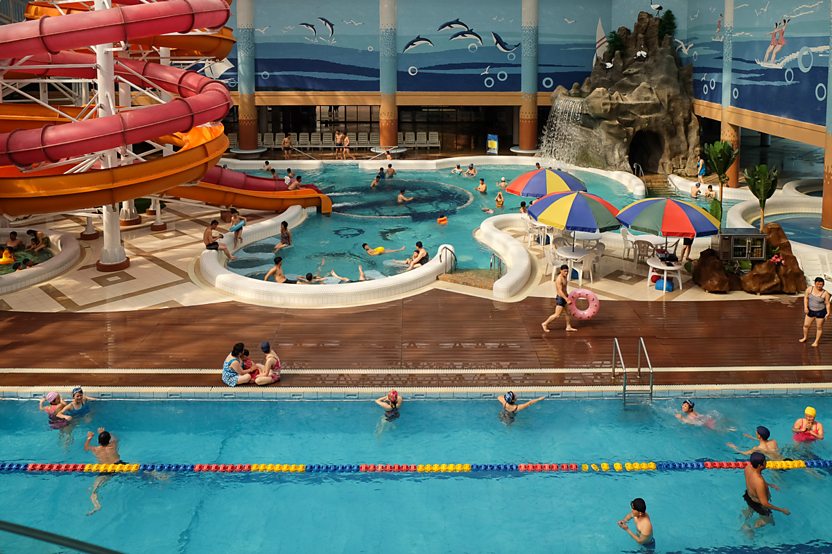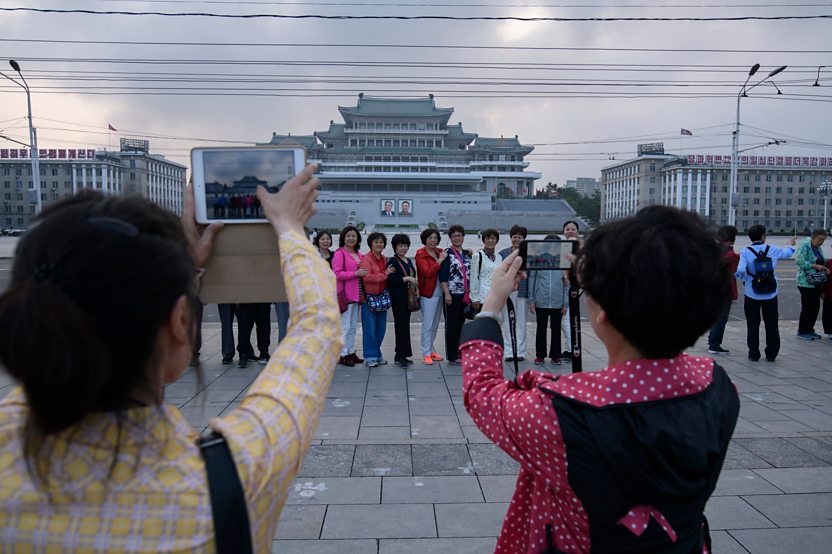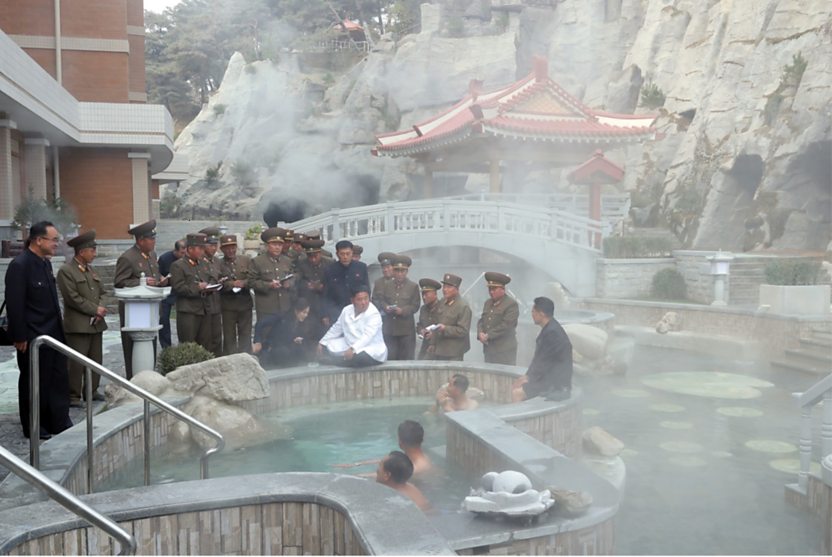김정은: 동방의 스위스가 되겠다는 꿈, 현실성은 얼마나 있나? - BBC News 코리아
김정은: 동방의 스위스가 되겠다는 꿈, 현실성은 얼마나 있나?
프레틱 자카르BBC 모니터링
2020년 2월 3일
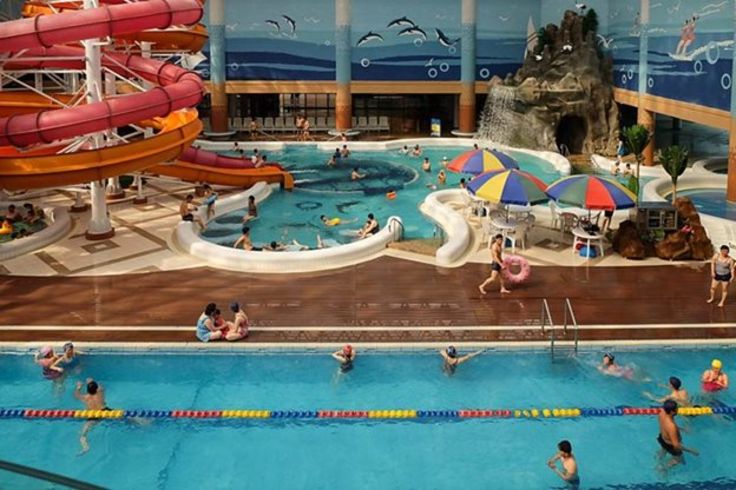
북한 관영매체들은 새 레저시설들이 '세계적 수준'을 갖추고 있다고 홍보하고 있다.
--
여타 저소득 국가들에 비하면, 북한은 문화 여가시설을 짓는데 투자를 아끼지 않고 있다.
김정은 정권 들어서 북한에는 리조트, 쇼핑몰, 놀이공원 등이 우후죽순으로 지어지고 있다. 그 중 가장 최근 선을 보인 것은 지난 1월에 문을 연 양덕군 온천문화휴양지다.
김정은 위원장은 2019년 한 해 최소 다섯 번 이상 양덕군을 방문해 공사 진행 상황을 확인하는 등 각별한 애정을 보였다. 그 중 한 번은 직접 책임자들을 만나 온천수 온도가 달걀을 삶을 수 있을 정도로 뜨거워야 한다고 지시했다는 후문이 있다.
지난달 백두 용암지대에 위치한 삼지연에 온천과 스키를 동시에 즐길 수 있는 리조트가 '현대 문명의 진수'라는 국영 매체의 열렬한 환호를 받으며 대중에 개방됐다.
김 위원장의 또 다른 야심찬 프로젝트인 원산-갈마 관광지구 역시 올 4월 완공을 앞두고 막바지 준비에 한창이다.
그렇다면 북한은 왜 이런 관광 시설들을 연달아 짓는 걸까?
동방의 스위스?
북한이 이렇게 관광 산업 육성에 열을 올리는 이유 중 가장 큰 것은 유엔 대북 제재 하에 석탄, 무기, 광물 등의 수출입이 불가능해진 것은 물론, 지난해 말 북한의 주요 외화수입원이던 해외 노동자들이 모두 북한으로 송환되면서 외화벌이 창구가 막혀버렸기 때문이다.
관광은 제재 대상이 아니기 때문에 외국인 관광객 유치는 외화를 벌어들일 수 있는 거의 유일한 수단이다.
북한전문매체인 NK 뉴스의 김정민 특파원은 BBC 모니터링과의 인터뷰에서 "관광 산업은 북한이 외국 자본을 벌어들일 수 있는 몇 가지 남지 않은 수단 중 하나"이라며 "북한의 매우 한정된 자원을 고려한다면 큰 자본이 들어가는 이런 프로젝트를 결정하기까지 오랜 심사숙고를 거쳤을 것"이라고 말했다.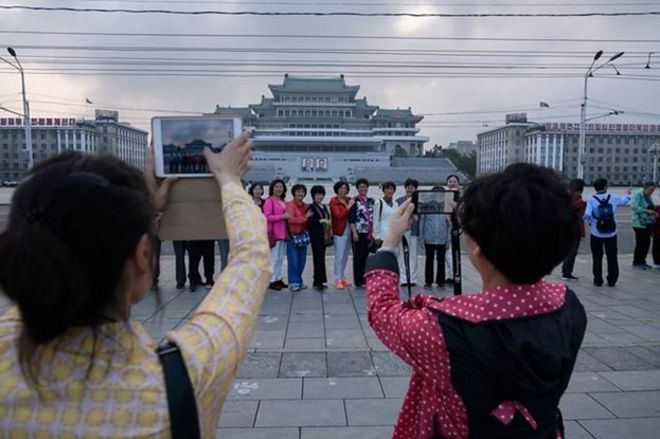 이미지 캡션2019년 한 해, 북한을 방문한 중국인 관광객 수는 역대 최고치를 기록했다.
이미지 캡션2019년 한 해, 북한을 방문한 중국인 관광객 수는 역대 최고치를 기록했다.
NK 뉴스는 2019년 한 해 동안 35만여 명의 중국인 관광객이 북한을 찾아 1억7500만 달러(약 2000여 억 원)의 관광 수익을 벌어들인 것으로 추산했다.
최근에는 한국 정부도 꽉 막힌 남북관계의 돌파구를 찾기 위해 북한 개별관광 추진을 공식화했다.
북한에도 고민은 있다, 관광 수입을 통한 외국 자본 유입은 환영할만하지만 북한 주민들과 외국 관광객들의 접촉이 잦아질수록 폐쇄적인 북한 사회에 외부 문화가 유입될 위험성이 커지기 때문이다.
김정민 특파원은 "이 때문에 북한은 몇몇 지역들만 제한적으로 관광객에게 공개하는 방식으로 지역 주민과 외국인들의 접촉을 최소화해왔다"고 말했다.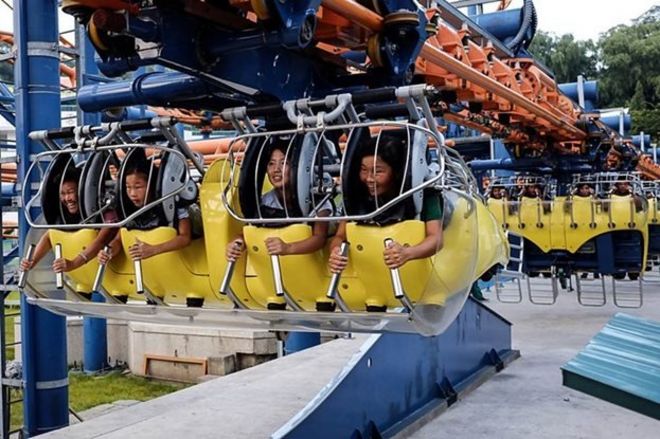 이미지 캡션북한에서 해외 관광은 정부에 의해 철저히 통제되고 있다.
이미지 캡션북한에서 해외 관광은 정부에 의해 철저히 통제되고 있다.
하지만 관광 시설을 짓는 것만으로는 북한이 기대하는 성과를 보기는 어려울 것으로 보인다.
국민대 동양학부 안드레이 란코브 교수는 "김정은 위원장이 경제적으로 부유한 서방 국가들의 관광객이 북한으로 몰려들 것으로 기대하고 있는 거라면 이 프로젝트의 실패는 불 보듯 뻔한 일"이라고 말했다.
그는 지난해 11월 초 데일리 NK 웹사이트에 게재된 기사를 통해 "관광 산업이 북한 경제 발전에 분명 어느 정도 도움은 되겠지만 그 한계도 분명하다"면서 "북한은 스위스가 아니기 때문"이라는 의견을 밝혔다.
걷잡을 수 없이 퍼지고 있는 신종 코로나바이러스 역시 김 위원장의 원대한 계획 추진에 걸림돌이 되고 있다. 북한은 최근 모든 외국인 관광객의 북한 입국을 전면 금지했다.
'애민' 선전
김 위원장이 여가 시설들을 통해서 얻으려고 하는 것은 관광 수입뿐만이 아니다. 지속적인 대북 제재로 어려워진 경제 상황에도 김 위원장은 자신이 건재하고 북한 체제가 안정적임을 과시하며 내부 결속력을 다지기 위한 수단으로 이 시설들을 이용하고 있다.
김정민 특파원은 "대북 제재에도 불구하고 주민들의 복지와 여가를 세심하게 챙기고 있음을 보이기 위해 이런 대규모 문화 공간 짓는 것으로 볼 수도 있다"고 설명했다.
북한은 최근 관영, 선전매체를 동원해 연일 대대적으로 새 문화 휴양지를 홍보하며 내부 선전 효과를 노리고 있다.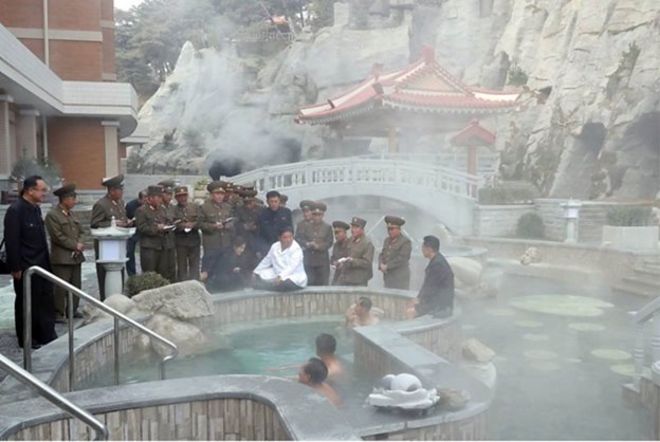 이미지 캡션북한 전문가들은 김정은이 주민들의 '웰빙'을 각별히 챙기고 있다는 것을 보이고 싶어한다고 말한다.
이미지 캡션북한 전문가들은 김정은이 주민들의 '웰빙'을 각별히 챙기고 있다는 것을 보이고 싶어한다고 말한다.
조선중앙TV에서 방영된 새로운 다큐멘터리에는 양덕 리조트와 삼지연군 건설 과정이 집중 조명되었고, 이를 가능하게 한 김정은의 업적을 찬양하는 내용이 담겼다.
또 지난달 20일부터 조선중앙TV 일기예보에는 평안남도 양덕군 온천관광지구 날씨가 포함된 것을 확인할 수 있다.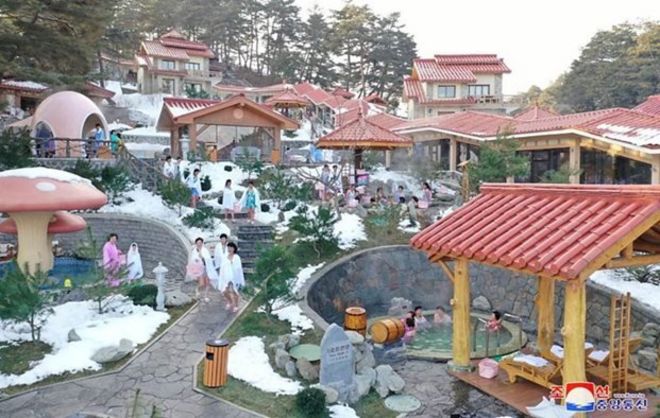 이미지 캡션전문가들은 김 위원장이 스위스에서 유년시절을 보내면서 현대식 리조트 시설에 대한 각별한 관심을 키웠을 것으로 추정하고 있다.
이미지 캡션전문가들은 김 위원장이 스위스에서 유년시절을 보내면서 현대식 리조트 시설에 대한 각별한 관심을 키웠을 것으로 추정하고 있다.
미국 외교정책연구소의 벤자민 카제프 실버스타인 연구원에 따르면, 1990년대와는 달리 요즘 북한 주민들은 먹고 사는 것 이상의 가치를 추구한다고 말한다.
그는 BBC 모니터링과의 인터뷰에서 "김 위원장은 어느 정도 경제력을 갖춘 중산층에게 즐길 거리를 제공하는 동시에, 대부분의 가난한 일반 주민들에게 당장 우리 지역은 아닐지 몰라도, 북한 경제가 전반적으로 발전하고 있다는 이미지를 심어주고 싶어한다"고 말했다.
그는 "김정은은 당찬 포부를 가진, 지금까지와는 다른 지도자로 보이길 원하고, 이런 레저 시설들로 그걸 표현하고 있다"고 덧붙였다.
북한에 부는 '건축 열풍'
북한의 현대적인 면모를 과시하고 민족적 자긍심을 고취하고자 하는 김 위원장의 욕심은 다른 건설 프로젝트들에서도 분명히 드러난다.
북한의 동해안에 위치하고 있는 원산-갈마 관광지구에는 바다가 한눈에 보이는 호텔과 스포츠 시설, 물놀이 시설들이 포함된 리조트 단지가 들어설 예정이다. 이미지 캡션원산-갈마 지구 완공 시점은 올해 4월 15일(태양절ㆍ김일성 주석 생일)에서 10월 10일(노동당 창건 기념일)로, 다시 내년 태양절로 자꾸 미뤄져왔다
이미지 캡션원산-갈마 지구 완공 시점은 올해 4월 15일(태양절ㆍ김일성 주석 생일)에서 10월 10일(노동당 창건 기념일)로, 다시 내년 태양절로 자꾸 미뤄져왔다
원산-갈마 지구는 원래 작년 10월 완공 예정이었지만 국제적인 제재로 건축 자재들이 부족해지면서 완공이 다시 한 번 연기되었다.
김 위원장은 한국 정부에 금강산 시설 철거를 요구한 뒤 '세계적인 명산'인 금강산을 '최고의 문화관광지구'로 만들겠다는 포부를 드러내기도 했다.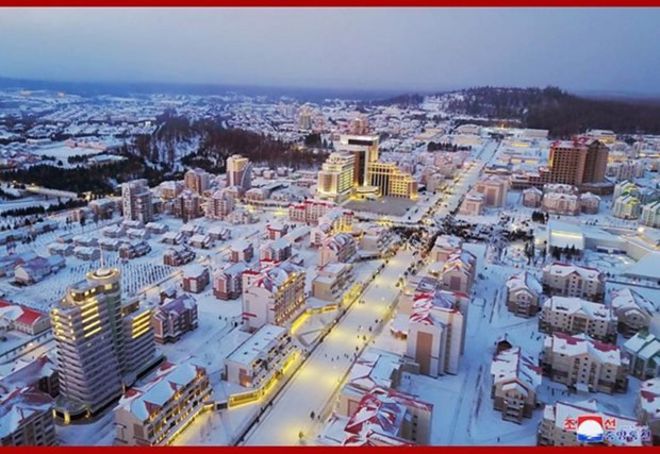 이미지 캡션김정은 체제 하에 북한은 굵직한 건설 프로젝트들을 추진해 왔다.
이미지 캡션김정은 체제 하에 북한은 굵직한 건설 프로젝트들을 추진해 왔다.
김정은 집권 하에 완공된 다른 건설 프로젝트에는 마식령 스키장, 강계 리조트, 53층 주상복합아파트 은하로 대표되는 미래과학자거리, 2017년 김일성 생일 105년을 맞아 추진한 려명거리 등이 있다.
하지만 전문가들은 이 같은 대규모 프로젝트들이 '빛 좋은 개살구'라며 실효성이 없다고 비판한다.
건설 프로젝트에 사람들의 노동력이 강제적으로 착취됐다는 의혹도 있다.
최근 삼지연 공사 현장의 열악한 노동 환경에 대해 폭로한 탈북자의 증언도 이어졌다.
그는 NK뉴스와 지난달 20일 이뤄진 인터뷰에서 "추위와 굶주림에 지금도 고통받고 있을 어린 노동자들을 생각하면 밤에도 잠을 이룰 수가 없다"고 말했다.
관련 토픽
김정은
북한
북한인권
관련 기사 더 보기
북한 경제: 청년들 사상 교육 강조하기 시작한 북한 정권
2019년 3월 12일
북한 인권: 미 의회 '북한 강제수용소 철폐 촉구'에 북한 맹비난
2018년 10월 5일
주요뉴스
--
여타 저소득 국가들에 비하면, 북한은 문화 여가시설을 짓는데 투자를 아끼지 않고 있다.
김정은 정권 들어서 북한에는 리조트, 쇼핑몰, 놀이공원 등이 우후죽순으로 지어지고 있다. 그 중 가장 최근 선을 보인 것은 지난 1월에 문을 연 양덕군 온천문화휴양지다.
김정은 위원장은 2019년 한 해 최소 다섯 번 이상 양덕군을 방문해 공사 진행 상황을 확인하는 등 각별한 애정을 보였다. 그 중 한 번은 직접 책임자들을 만나 온천수 온도가 달걀을 삶을 수 있을 정도로 뜨거워야 한다고 지시했다는 후문이 있다.
지난달 백두 용암지대에 위치한 삼지연에 온천과 스키를 동시에 즐길 수 있는 리조트가 '현대 문명의 진수'라는 국영 매체의 열렬한 환호를 받으며 대중에 개방됐다.
김 위원장의 또 다른 야심찬 프로젝트인 원산-갈마 관광지구 역시 올 4월 완공을 앞두고 막바지 준비에 한창이다.
그렇다면 북한은 왜 이런 관광 시설들을 연달아 짓는 걸까?

동방의 스위스?
북한이 이렇게 관광 산업 육성에 열을 올리는 이유 중 가장 큰 것은 유엔 대북 제재 하에 석탄, 무기, 광물 등의 수출입이 불가능해진 것은 물론, 지난해 말 북한의 주요 외화수입원이던 해외 노동자들이 모두 북한으로 송환되면서 외화벌이 창구가 막혀버렸기 때문이다.
관광은 제재 대상이 아니기 때문에 외국인 관광객 유치는 외화를 벌어들일 수 있는 거의 유일한 수단이다.
북한전문매체인 NK 뉴스의 김정민 특파원은 BBC 모니터링과의 인터뷰에서 "관광 산업은 북한이 외국 자본을 벌어들일 수 있는 몇 가지 남지 않은 수단 중 하나"이라며 "북한의 매우 한정된 자원을 고려한다면 큰 자본이 들어가는 이런 프로젝트를 결정하기까지 오랜 심사숙고를 거쳤을 것"이라고 말했다.
 이미지 캡션2019년 한 해, 북한을 방문한 중국인 관광객 수는 역대 최고치를 기록했다.
이미지 캡션2019년 한 해, 북한을 방문한 중국인 관광객 수는 역대 최고치를 기록했다.NK 뉴스는 2019년 한 해 동안 35만여 명의 중국인 관광객이 북한을 찾아 1억7500만 달러(약 2000여 억 원)의 관광 수익을 벌어들인 것으로 추산했다.
최근에는 한국 정부도 꽉 막힌 남북관계의 돌파구를 찾기 위해 북한 개별관광 추진을 공식화했다.
북한에도 고민은 있다, 관광 수입을 통한 외국 자본 유입은 환영할만하지만 북한 주민들과 외국 관광객들의 접촉이 잦아질수록 폐쇄적인 북한 사회에 외부 문화가 유입될 위험성이 커지기 때문이다.
김정민 특파원은 "이 때문에 북한은 몇몇 지역들만 제한적으로 관광객에게 공개하는 방식으로 지역 주민과 외국인들의 접촉을 최소화해왔다"고 말했다.
 이미지 캡션북한에서 해외 관광은 정부에 의해 철저히 통제되고 있다.
이미지 캡션북한에서 해외 관광은 정부에 의해 철저히 통제되고 있다.하지만 관광 시설을 짓는 것만으로는 북한이 기대하는 성과를 보기는 어려울 것으로 보인다.
국민대 동양학부 안드레이 란코브 교수는 "김정은 위원장이 경제적으로 부유한 서방 국가들의 관광객이 북한으로 몰려들 것으로 기대하고 있는 거라면 이 프로젝트의 실패는 불 보듯 뻔한 일"이라고 말했다.
그는 지난해 11월 초 데일리 NK 웹사이트에 게재된 기사를 통해 "관광 산업이 북한 경제 발전에 분명 어느 정도 도움은 되겠지만 그 한계도 분명하다"면서 "북한은 스위스가 아니기 때문"이라는 의견을 밝혔다.
걷잡을 수 없이 퍼지고 있는 신종 코로나바이러스 역시 김 위원장의 원대한 계획 추진에 걸림돌이 되고 있다. 북한은 최근 모든 외국인 관광객의 북한 입국을 전면 금지했다.

'애민' 선전
김 위원장이 여가 시설들을 통해서 얻으려고 하는 것은 관광 수입뿐만이 아니다. 지속적인 대북 제재로 어려워진 경제 상황에도 김 위원장은 자신이 건재하고 북한 체제가 안정적임을 과시하며 내부 결속력을 다지기 위한 수단으로 이 시설들을 이용하고 있다.
김정민 특파원은 "대북 제재에도 불구하고 주민들의 복지와 여가를 세심하게 챙기고 있음을 보이기 위해 이런 대규모 문화 공간 짓는 것으로 볼 수도 있다"고 설명했다.
북한은 최근 관영, 선전매체를 동원해 연일 대대적으로 새 문화 휴양지를 홍보하며 내부 선전 효과를 노리고 있다.
 이미지 캡션북한 전문가들은 김정은이 주민들의 '웰빙'을 각별히 챙기고 있다는 것을 보이고 싶어한다고 말한다.
이미지 캡션북한 전문가들은 김정은이 주민들의 '웰빙'을 각별히 챙기고 있다는 것을 보이고 싶어한다고 말한다.조선중앙TV에서 방영된 새로운 다큐멘터리에는 양덕 리조트와 삼지연군 건설 과정이 집중 조명되었고, 이를 가능하게 한 김정은의 업적을 찬양하는 내용이 담겼다.
또 지난달 20일부터 조선중앙TV 일기예보에는 평안남도 양덕군 온천관광지구 날씨가 포함된 것을 확인할 수 있다.
 이미지 캡션전문가들은 김 위원장이 스위스에서 유년시절을 보내면서 현대식 리조트 시설에 대한 각별한 관심을 키웠을 것으로 추정하고 있다.
이미지 캡션전문가들은 김 위원장이 스위스에서 유년시절을 보내면서 현대식 리조트 시설에 대한 각별한 관심을 키웠을 것으로 추정하고 있다.미국 외교정책연구소의 벤자민 카제프 실버스타인 연구원에 따르면, 1990년대와는 달리 요즘 북한 주민들은 먹고 사는 것 이상의 가치를 추구한다고 말한다.
그는 BBC 모니터링과의 인터뷰에서 "김 위원장은 어느 정도 경제력을 갖춘 중산층에게 즐길 거리를 제공하는 동시에, 대부분의 가난한 일반 주민들에게 당장 우리 지역은 아닐지 몰라도, 북한 경제가 전반적으로 발전하고 있다는 이미지를 심어주고 싶어한다"고 말했다.
그는 "김정은은 당찬 포부를 가진, 지금까지와는 다른 지도자로 보이길 원하고, 이런 레저 시설들로 그걸 표현하고 있다"고 덧붙였다.

북한에 부는 '건축 열풍'
북한의 현대적인 면모를 과시하고 민족적 자긍심을 고취하고자 하는 김 위원장의 욕심은 다른 건설 프로젝트들에서도 분명히 드러난다.
북한의 동해안에 위치하고 있는 원산-갈마 관광지구에는 바다가 한눈에 보이는 호텔과 스포츠 시설, 물놀이 시설들이 포함된 리조트 단지가 들어설 예정이다.
 이미지 캡션원산-갈마 지구 완공 시점은 올해 4월 15일(태양절ㆍ김일성 주석 생일)에서 10월 10일(노동당 창건 기념일)로, 다시 내년 태양절로 자꾸 미뤄져왔다
이미지 캡션원산-갈마 지구 완공 시점은 올해 4월 15일(태양절ㆍ김일성 주석 생일)에서 10월 10일(노동당 창건 기념일)로, 다시 내년 태양절로 자꾸 미뤄져왔다원산-갈마 지구는 원래 작년 10월 완공 예정이었지만 국제적인 제재로 건축 자재들이 부족해지면서 완공이 다시 한 번 연기되었다.
김 위원장은 한국 정부에 금강산 시설 철거를 요구한 뒤 '세계적인 명산'인 금강산을 '최고의 문화관광지구'로 만들겠다는 포부를 드러내기도 했다.
 이미지 캡션김정은 체제 하에 북한은 굵직한 건설 프로젝트들을 추진해 왔다.
이미지 캡션김정은 체제 하에 북한은 굵직한 건설 프로젝트들을 추진해 왔다.김정은 집권 하에 완공된 다른 건설 프로젝트에는 마식령 스키장, 강계 리조트, 53층 주상복합아파트 은하로 대표되는 미래과학자거리, 2017년 김일성 생일 105년을 맞아 추진한 려명거리 등이 있다.
하지만 전문가들은 이 같은 대규모 프로젝트들이 '빛 좋은 개살구'라며 실효성이 없다고 비판한다.
건설 프로젝트에 사람들의 노동력이 강제적으로 착취됐다는 의혹도 있다.
최근 삼지연 공사 현장의 열악한 노동 환경에 대해 폭로한 탈북자의 증언도 이어졌다.
그는 NK뉴스와 지난달 20일 이뤄진 인터뷰에서 "추위와 굶주림에 지금도 고통받고 있을 어린 노동자들을 생각하면 밤에도 잠을 이룰 수가 없다"고 말했다.
관련 토픽
김정은
북한
북한인권
관련 기사 더 보기
북한 경제: 청년들 사상 교육 강조하기 시작한 북한 정권
2019년 3월 12일
북한 인권: 미 의회 '북한 강제수용소 철폐 촉구'에 북한 맹비난
2018년 10월 5일
주요뉴스
----------------
Insight


